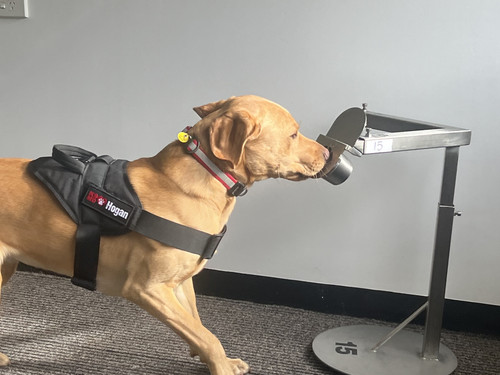A Medical Diagnostic Tool
A dog’s nose is absolutely incredible. Where a human has 5 million scent receptors in their nose, a dog has up to 300 million. The part of a dog’s brain devoted to analysing smell is 40 times greater than ours. Their sense of smell is up to 100,000 times more accurate than a humans.
It is hard to comprehend the magnitude of a dog’s ability to smell. They are able to layer scent. Where you or I can smell a casserole cooking, a dog can detect each individual ingredient within the casserole; meat, carrot, onion, potato, etc.
Dogs also smell in stereo, meaning that their two nostrils can operate independently. This two pronged approach allows dogs to determine not only the identity of a smell but also from where it came.
Sniffing
Dogs use sniffing to maximise the detection of odours. Their normal breathing is disrupted by a series of rapid inhalations and expirations.
Each nostril sniffs from separate areas ensuring a bilateral scent intake.
A very unique property of the canine olfactory receptor cell is that they are constantly regenerating, about every 30-60 days. No other mammalian sensory cell is known to have this capability. What is even more interesting, is that the new olfactory receptors regenerated, are triggered by the odours to which the canine is being exposed. This, over time, allows them to develop more olfactory receptors at a higher density for those particular odours the canine is being exposed to. This is one reason why dogs trained to detect explosives, narcotics or disease, can detect smaller and smaller quantities with repeated exposure (and reward) for the same odours, because of the increased density of the olfactory receptors that are triggered by those odours.
No Secrets
A dog is able to smell when you are happy, nervous or scared by smelling your hormones.
Research indicates that a dog’s sense of smell can detect fear, anxiety and even sadness. They can read your emotions through tiny amounts of perspiration or adrenaline. Fear or anxiety is most often accompanied by an increase in heart rate and blood flow. This sends body chemicals to the skin surface which a dog can detect, so trying to hide your true feelings may fool your friends but not your dog. Because we shed 50 million skin cells every minute a dog can smell fingerprints on a wall that are weeks old. They can also tell in which direction you walked a long time after you left.
In addition to being able to sniff out substances, dogs have a second scent receptor in their nose called a vomeronasal organ that is dedicated solely to sniffing out pheromones. This makes it possible for a dog to identify potential mates, differentiate between friendly and potential enemies, identify when someone is pregnant, and notice when someone is getting sick.
A dog’s sense of smell is so strong that they can detect the equivalent of one teaspoon of sugar in two Olympic sized swimming pools of water.





